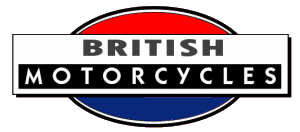


Sloping top tube loop frame gives a low saddle position on the 169 c.c. J.E.S.; the size of the silencer compared with the cylinder capacity is noteworthy.
Single-gear Belt-drive and Three-speed Chain-drive 169 c.c. Lightweights and New Larger Model
FOR many years Mr. J. E. Smith, of Gloucester, ploughed rather a lonely furrow with his excellently designed and constructed miniature engines and motorised bicycles.
His business is now styled the J.E.S. Motor Co. (Gloucester), Ltd., and next year will produce a range of machines extended by a 247 c.c. two-stroke equipped with a four-speed gear.
The engine of this machine is of the three-port type with a roller bearing big end, lubrication being automatic by pressure and suction; the carburetter is an Amac.
Saddle height of 28in. is obtained by a sloping top tube frame and the transmission is by chain throughout, through the J.E.S. four-speed box, which is mounted above the bottom bracket. The gears are of the constant mesh type, changes being effected by a sliding key, on the lines of machine-tool practice. The ratios are 5, 8, 12 and 15 to 1, and there is a shock absorber in the rear hub; the main brake is of the expanding type in the rear hub. The tyres are 26 x 2¼ in.
The 159 c.c. models have two-stroke engines of the type which distinguished itself in the A.C.U. Six Days Trials, but one has a three-speed gear box with clutch and kick-starter and the other has direct belt drive.
J.E.S. machines are priced as follows: 169 c.c. single-speed, £30 9s.; 169 c.c. three-speed, all- chain, £47 5s.; and 247 c.c. four-speed, all-chain, £59 17s.
The Motor Cycle November 9th, 1922.
The 1922 Olympia Show.
J.E.S. (Stand 38.)
Four speed 150 lb. Lightweight.
2½ H.P. Model.
68x68 mm. (247 c.c.); single-cyl. two-stroke; automatic lubrication; Amac carburetter; chain-driven mag.; 4-sp. gear; clutch and kick-starter; chain drive; 26x2¼ in. tyres. Price, £59 17s.
J.E.S. MOTOR Co. (Gloucester), Ltd.
This year's Six Days Trials demonstrated that the 169 c.c. J.E.S. with four-speed gear box was a go-anywhere machine; there should therefore be no doubt as to the capabilities of the new 247 c.c. model which forms the chief exhibit.
The gear box is the same as was used on the smaller model in the A.C.U. Trials, but the engine is a new production, although on quite conventional lines. It is of the three-port type, and has a roller- bearing big end. Lubrication is by crank case pressure controllable by an adjustable drip feed. Special attention has been paid to balance. Quite a novel principle for motor cycles is applied in the diminutive four-speed gear box. The pinions are in constant mesh, and each pair in turn is dogged to the main and lay-shafts. Thus the drive on each gear is indirect. Similar designs are often employed in machine tools. Other important features include a massive internal expanding rear brake, a slightly smaller front brake, and girder spring forks. Transmission is by chain, and there is a shock absorber in the rear hub. Complete, this workmanlike little motor cycle weighs only 150 lb.
1¾ H.P. Model.
60x60 mm. (169 c.c); single cyl. two-stroke; automatic lubrication; Amac carburetter; chain-driven mag.; 3-sp. gear; no clutch or kick-starter; chain drive; 24x 2in. tyres. Price, £45.
The 159 c.c. miniature is shown in two forms, with direct belt drive at £29, or to the above specification with a new three-speed gear box and final chain drive at the price stated. In the first case a belt rim rear brake is employed, but on the more elaborate model the internal expanding type, as on the 247 c.c. machine, is repeated.
Olympia Show 1922
The Motor Cycle, November 30th, 1922. Page 847
If you have further information or a query related to this page, please contact us